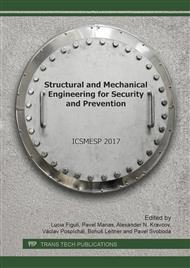[1]
Haldimann M, Luible A, Overend M (2008). Structural Use of Glass. ISBN 978-3-85748-119-2.
Google Scholar
[2]
Larcher M, Arrigoni M, Bedon C, Van Doormaal J.C.A.M., Haberacker C, Hüsken G, Millon O, Saarenheimo A, Solomos G, Thamie L, Valsamos G, Williams A, Stolz A (2016).
DOI: 10.4028/www.scientific.net/kem.755.121
Google Scholar
[3]
Luible A, Crisinel M (2004). Buckling strength of glass elements in compression. Structural Engineering International, 2004: 120-125.
DOI: 10.2749/101686604777964107
Google Scholar
[4]
Amadio C, Bedon C (2011). Buckling of laminated glass elements in compression. Journal of Structural Engineering, 137(8): 803-810.
DOI: 10.1061/(asce)st.1943-541x.0000328
Google Scholar
[5]
Bedon C, Amadio C (2015). Design buckling curves for glass columns and beams. Structures & Buildings, 168(7): 514-526.
DOI: 10.1680/stbu.13.00113
Google Scholar
[6]
Bedon C, Amadio C (2014). Flexural-torsional buckling: experimental analysis of laminated glass elements. Engineering Structures 73(8): 85-99.
DOI: 10.1016/j.engstruct.2014.05.003
Google Scholar
[7]
Foraboschi P (2009). Buckling of a laminated glass column under test. The Structural Engineer, 87: 20-2.
Google Scholar
[8]
Aiello S, Campione G, Minafò G, Scibilia N (2011). Compressive behaviour of laminated structural glass members. Engineering Structures, 33(12): 3402-3408.
DOI: 10.1016/j.engstruct.2011.07.004
Google Scholar
[9]
Bedon C, Amadio C, Sinico A (2014). Numerical and analytical investigation on the dynamic buckling behavior of glass columns under blast. Engineering Structures, 79: 322-340.
DOI: 10.1016/j.engstruct.2014.08.024
Google Scholar
[10]
Kalamar R, Bedon C, Eliášová M (2016). Experimental investigation for the structural performance assessment of square hollow glass columns. Engineering Structures, 113(4): 1-15.
DOI: 10.1016/j.engstruct.2016.01.028
Google Scholar
[11]
ABAQUS computer software v. 6. 12, Simulia.
Google Scholar
[12]
Zhang X, Hao H, Ma G (2013). Laboratory test and numerical simulation of laminated glass window vulnerability to debris impact. International Journal of Impact Engineering 55: 49-62.
DOI: 10.1016/j.ijimpeng.2013.01.002
Google Scholar
[13]
Pelfrene J, Kuntsche J, Van Dam S, Van Paepegem W, Schneider J (2016). Critical assessment of the post-breakage performance of blast loaded laminated glazing: experiments and simulations. International Journal of Impact Engineering, 88: 61-71.
DOI: 10.1016/j.ijimpeng.2015.09.008
Google Scholar
[14]
Larcher M, Solomos G, Casadei F, Gebbeken N (2012). Experimental and numerical investigations of laminated glass subjected to blast loading. International Journal of Impact Engineering, 39(1): 42-50.
DOI: 10.1016/j.ijimpeng.2011.09.006
Google Scholar
[15]
Forde LC, Proud WG, Walley SM, Church PD, Cullis IG (2010). Ballistic impact studies of a borosilicate glass. International Journal of Impact Engineering, 37(5): 568–578.
DOI: 10.1016/j.ijimpeng.2009.10.005
Google Scholar
[16]
Costas G, Fountzoulas G, Parimai JP (2012). Numerical study of the effect of small size flaws on the ballistic behavior of transparent laminated targets. Ceramic Armor VIII – Ceramic Engineering and Science Proceedings, pp.53-64.
DOI: 10.1002/9781118217498.ch5
Google Scholar
[17]
Walley SM (2014). An Introduction to the Properties of Silica Glass in Ballistic Applications. Strain, 50(6): 470-500.
DOI: 10.1111/str.12075
Google Scholar
[18]
Jacob L, Davies P S, Rice S, Yang J (2003). Safety glass impact test developments. Proceedings of Glass Performance Days 2003: 725-728.
Google Scholar
[19]
Oketani Y, Kikuta M, Aratani S (2003). Experimental study of shot bag impactor for international standardization. Proceedings of Glass Performance Days 2004: 740-742.
Google Scholar
[20]
EN 12600: 2002. Glass in Building – Pendulum Test – Impact Test Method and Classification for Flat Glass. CEN – European Committee for Standardization, Brussels.
DOI: 10.3403/02726245u
Google Scholar
[21]
EN 572–2: 2004. Glass in buildings – Basic soda lime silicate glass products. CEN – European Committee for Standardization, Brussels.
Google Scholar
[22]
Sika® (2013). SikaFast®-5211 NT Fast-Curing – Two-Part Structural Adhesive – Product Data Sheet, www. sika. com.
Google Scholar
[23]
Bedon C, Louter C (2014). Exploratory numerical analysis of SG-laminated reinforced glass beam experiments. Engineering Structures, 75: 457-46.
DOI: 10.1016/j.engstruct.2014.06.022
Google Scholar


